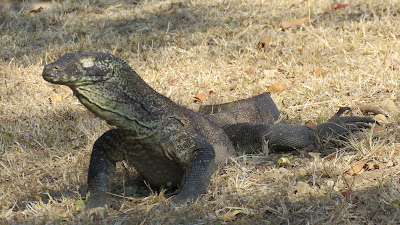Komodo Dragons.
One of the 14 species of flying squirrel found in
Borneo.
Mother and baby silver backed lemur.
A sleepy proboscis monkey with dental problems.
Jimmy Durante of the forest.
Ritchie the alpha orangutan of the Semenggoh Wildlife Centre.
Thank you Louis and Selvam.
Louis posted this on the internal G website, I wonder how many of my other guides from the 17 G trips will see it.
Summary
Here are a few pieces of information, thoughts and
feelings about my time in Indonesia and Malaysia.
My main reason for coming to Indonesia and Malaysia
was to see the nature. I wanted to go to Komodo Island in 2011 to see the dragons
but, I couldn’t fit it into my itinerary, so getting there this year was a
fulfillment of that dream. I have seen gorillas in the wild and I hoped with a
visit to Borneo I would see an orangutan in the wild. Observing animals in the
wild is always hit or miss but thankfully, I realized both dreams. Seeing the
proboscis and silver backed lemurs were also a bonus. But, the one thing I was
disappointed about in both countries was the lack of birds. In Borneo I got two
glossy pamphlets on birds of the country, but other than one glimpse at a rufous
backed kingfisher, we saw nothing of interest. There are several species of
hornbills in Borneo including the rhinoceros hornbill, that I would have loved
to see. I know the visibility in the rainforest is a big problem as many of the
birds live in the canopy up high off the ground. But, still I expected to see
some.
Interesting fact about proboscis monkeys is that they have two stomachs like cows and eat their fill which is digested in the second one. They eat only plants and no fruits because the sugars cause them digestive distress and bloating and if they eat too much they can die.
Interesting fact about proboscis monkeys is that they have two stomachs like cows and eat their fill which is digested in the second one. They eat only plants and no fruits because the sugars cause them digestive distress and bloating and if they eat too much they can die.
Borneo is the 3rd largest island in the
world. Sarawak alone is 120 000 sq km and used to be part of Brunei but somehow
a British adventurer named James Brook came to own it and he became the 1st
white raja. Then it was occupied by the Japanese during World War II, and then
briefly by the Australian army after the Japanese were defeated. Then the
British took it over after the war until 1963.
Malaysia became a unified country 1963. It was
supposed to be five places joining to form one country: Sarawak, Sabah, Brunei,
Singapore and Peninsula Malaysia (Kuala Lumpur is). But while they were
negotiating oil deposits were discovered along the north shore of Borneo, and
Brunei pulled out to be able to control their share, and then Singapore decided
they wanted to remain independent. So, the other three combined to make
Malaysia, but they are two different pieces of land. Peninsula Malaysia is
connected to Thailand; and Sarawak and Sabah are on the island of Borneo which
they share with Indonesia and are divided by a mountain range. The country of
Brunei (where my English buddy John lived for years) is sandwiched between
them.
Although I booked this as one trip, it was in fact
two. The first half was in the state of Sabah and the second was in Sarawak. I
preferred the second half as it was more of what I expected in Borneo with
animal sightings and a visit to a tribal community. We were very fortunate to
have two excellent guides, Louis from GAdventures and Selvam who works for a
local company. The two of them have worked together over a dozen times and get
along very well. Between them they have 60 years of experiences exploring and
leading tours in their country. They are both incredibly passionate and
knowledgeable about their country. They were helpful, energetic and provided us
with a very full itinerary. There was very little down time.
From the time I spent in both countries, I found
Malaysia to be much better developed than Indonesia. The latter is still very
much a third world country whereas Malaysia is a second world country. Its
cities are developing quickly, but there are vast areas of wilderness and
remote peoples still living in traditional ways without electricity or many connections
with the modern world. The country is doing as much as possible to protect its
wildlife but when the native people rely on hunting for subsistence and
clearing jungle to grow crops, it takes a toll on the animals. And because the
rural tribes are living peacefully with each other (and not collecting heads)
the population is growing rapidly and that puts further pressure on the
wildlife, in particular the orangutans and rhinos. The government has made
killing or capturing a large number of species illegal and threaten large fines
and years of imprisonment, but too many people always threaten animals. I don’t
know how the government can monitor what goes on in the jungle. Maybe with the
increase in tourism and the fact that most tourist come to see the wildlife,
that will give the people a reason for protecting them. It remains to be seen
what happens here in the next few decades.











No comments:
Post a Comment